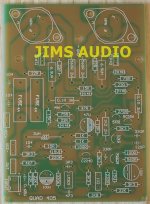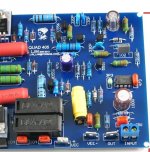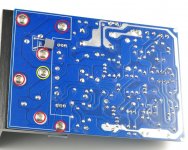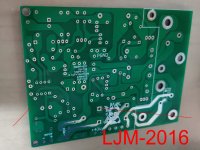You're right. In fact, we are on the Internet.We can translate by: "Subjective sound quality does not necessarily mean high technical specifications."
🙂
There is no way to really know whether the sound is good or bad. Thd cannot. All data are not allowed.
This is true.
But relatively speaking. I've heard all of them. If the effect is good. Why don't I sell quad707.
I produced it 10 years ago.
Obviously. It's not good. Quad606 is the same.
There are many people in China DIY quad606. About ten years ago.
But now few people make quad606. Because people don't like it.
And quad405 until Many people make it
Many people still assemble it. Quad405 is not a particularly good amplifier.
For example, its thd is not low. The frequency response should not be very good.
But I found that the designer of quad405 deliberately removed some low frequencies. And high frequency signal.
It was intentional. This is to meet the requirements of matching ls3/5a at that time. A way to make the audience feel comfortable.
So its data doesn't explain the problem. I still say the same.
Do not change quad405.
If you like amplifiers with good data, there are many circuits you can make.
Member
Joined 2006
Sorry for off topic a bit... which amplifiers are your favorite in terms of good sounding? 😀If you like amplifiers with good data, there are many circuits you can make.
Every designer must like the circuit he designs. Instead of imitating British products from the 1970s.Sorry for off topic a bit... which amplifiers are your favorite in terms of good sounding? 😀
If I think imitation can do the best. I won't design the amplifier myself.
So you ask me what circuit I like. Maybe l20v10, l20se. L25。
These three amplifiers. It is not the smallest circuit of thd. The smallest thd circuit I designed is l20.5 (THD 0.0015% 50W) and l12-2 (THD 0.0006%). But this is not my favorite. I prefer l20se L25.
Because thd is in practical application. It doesn't mean good or bad. Maybe a thd 0.2 amplifier is better than a thd 0.001%.
L20se L25 or l20v10 has better driving force. It sounds like a good low frequency. Very fast.
of course. I think the mx50se amplifier is the most cost-effective.
Let me add. In the same structure. BJT performance is better than MOSFET.
Hello
greetings i would love to make a QUAD 405 clone with
the schematic posted i have most parts except the small
transistors are there any replacements for ZTX504/ZTX304
BC214C.
warm regards
Andrew
greetings i would love to make a QUAD 405 clone with
the schematic posted i have most parts except the small
transistors are there any replacements for ZTX504/ZTX304
BC214C.
warm regards
Andrew
its thd is not low.
0.01%
15-55Khz. The high-pass is two-pole.The frequency response should not be very good.
All amplifiers have limited bandwidth. How limited is a decision every designer has to make.But I found that the designer of quad405 deliberately removed some low frequencies. And high frequency signal.
It was intentional.
It had nothing to do with the LS35/A whatsoever. It was to stabilize the amplifier, as stated in the WW article by PJW. If you have evidence to the contrary please produce it.This is to meet the requirements of matching ls3/5a at that time. A way to make the audience feel comfortable.
Please don't post opinion as fact.
I made this PCB in 2012.Hello ljm-ljm
greetings found this quad 405 pcb i have all parts
printed on the pcb i it k to build it.
warm regards
Andrew
Then many people in China copied it. Although I am not an inventor.
Please note that his vcc+ is wrong. It should be from top to bottom.
Instead of walking around. Because I designed it. So I know its mistake. I revised it in 2016.
Attachments
Almost everyone uses the quad405 DIY version.0.01%
15-55Khz. The high-pass is two-pole.
All amplifiers have limited bandwidth. How limited is a decision every designer has to make.
It had nothing to do with the LS35/A whatsoever. It was to stabilize the amplifier, as stated in the WW article by PJW. If you have evidence to the contrary please produce it.
Please don't post opinion as fact.
It's all made by me. Of course I measure it.
In fact, the performance of quad405 is completely different from what you said.
Its distortion is not 0.01 but 0.02-0.1%
The attenuation of low frequency and high frequency is very serious. This has nothing to do with amplifier stability.
This is common sense. This is only determined by the setting parameters of the filter. Mainly change the habit of listening.
Not stability. Any amplifier can work stably at a lower frequency.
Quad405 is not an excellent amplifier.
But it is a nostalgic amplifier.
Attachments
-
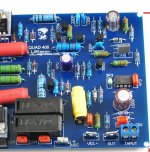 405-2.jpg153.9 KB · Views: 214
405-2.jpg153.9 KB · Views: 214 -
 QUAD405.jpg122.7 KB · Views: 177
QUAD405.jpg122.7 KB · Views: 177 -
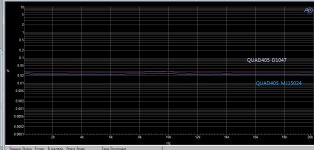 QUAD405-1047-15024.jpg112.1 KB · Views: 179
QUAD405-1047-15024.jpg112.1 KB · Views: 179 -
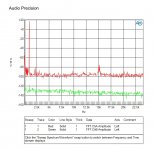 QUAD405-fft.jpg105.9 KB · Views: 163
QUAD405-fft.jpg105.9 KB · Views: 163 -
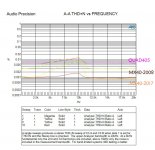 QUAD-MX40.jpg104.6 KB · Views: 174
QUAD-MX40.jpg104.6 KB · Views: 174 -
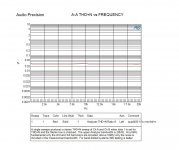 QUAD405-thd.jpg94 KB · Views: 176
QUAD405-thd.jpg94 KB · Views: 176 -
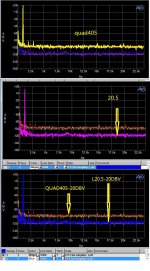 TB2dqLqeb3nBKNjSZFMXXaUSFXa_!!36508936.jpg417.2 KB · Views: 170
TB2dqLqeb3nBKNjSZFMXXaUSFXa_!!36508936.jpg417.2 KB · Views: 170 -
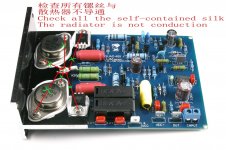 405-3.JPG299.2 KB · Views: 221
405-3.JPG299.2 KB · Views: 221 -
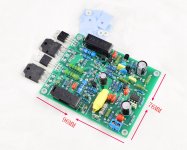 405-2.jpg382.8 KB · Views: 213
405-2.jpg382.8 KB · Views: 213 -
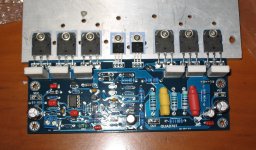 IMG_2977.jpg257.5 KB · Views: 251
IMG_2977.jpg257.5 KB · Views: 251
The att
In fact, the performance of quad405 is completely different from what you said.
Its distortion is not 0.01 but 0.02-0.1%
Never seen that, in hundreds of examples, unles faulty. I have consistently seen under 0.01% in 405-2 onwards.
'Extremely serious' is opinion. 15-55KHz with a two-pole HP is fact. Amplifiers with this bandwidth are legion, and they don't get singled out as having 'very serious' bandwidth problems.The attenuation of low frequency and high frequency is very serious.
Any amplifier with global NFB has to integrate above some high frequency limit to avoid instability. This is fact from control theory. Not opinion.This has nothing to do with amplifier stability.
As mentioned, the amp (circuit post #49) is sounding good with the TL 071CP op-amps giving less than 1 mv offset. I tried a pair of NE 5534P I have, but the DC bias increased to 16.1/16.3 mv, and sounded duller but deeper bass. Strange.
Do not use ne5534As mentioned, the amp (circuit post #49) is sounding good with the TL 071CP op-amps giving less than 1 mv offset. I tried a pair of NE 5534P I have, but the DC bias increased to 16.1/16.3 mv, and sounded duller but deeper bass. Strange.
The original version of quad405 uses lm301a
Ne5534 has a larger working current. It will be unstable.
Its compensation capacitance is different.
Lm301a has a smaller offset voltage.
Higher current does not imply instability. This is not a unity gain circuit, so compensation is irrelevant. It will not be unstable. I've fitted many of them, as recently as last week. You do get a higher DC offset, and for that reason I prefer OPA134. I have also used LME49710 when they were available in DIP-8.Do not use ne5534
The original version of quad405 uses lm301a
Ne5534 has a larger working current. It will be unstable.
Its compensation capacitance is different.
Lm301a has a smaller offset voltage.
There is really no reason to even mention LM301 in this day and age. Quad stopped using them, and so should we.
Last edited:
LM301 is actually very good. I've tried many operational amplifiers.Higher current does not imply instability. This is not a unity gain circuit, so compensation is irrelevant. It will not be unstable. I've fitted many of them, as recently as last week. You do get a higher DC offset, and for that reason I prefer OPA134. I have also used LME49710 when they were available in DIP-8.
There is really no reason to even mention LM301 in this day and age. Quad stopped using them, and so should we.
At least on the quad 405.
The original machine of quad405 also uses LM301.
The quad you mentioned is not used. It is 405-2 or 606
The working current actually has a great influence. Because the current supplied by the operational amplifier of quad405 is very low. So in the DIY version.
If you use a lower voltage. The current supplied by the operational amplifier will be insufficient.
Instability may occur. Huge distortion.
I have been making quad405 for more than 16 years. Including quad606 707.
In fact, the effect of quad707 is worse than that of quad405. Not better.
https://www.diyaudio.com/community/threads/quad707-design-documents.388336/
The quad you mentioned is not used. It is 405-2 or 606
I don't know what this means. Quad stopped using the LM301 several board revisions before the 405-2. You seem to be trying to convince us that Quad should not have changed to the TL071, and that their customers like recording studios, the BBC, etc. did not notice the degradation you appear to be alleging.
If you use a lower voltage it isn't a 405 at all, it is something else.If you use a lower voltage. The current supplied by the operational amplifier will be insufficient.
I have been servicing real ones for longer.I have been making quad405 for more than 16 years.
What about modern OP-Amps from TI in this application ?LM301 is actually very good. I've tried many operational amplifiers.
At least on the quad 405.
The original machine of quad405 also uses LM301.
check out also post #2490 under
https://www.diyaudio.com/community/threads/the-best-sounding-audio-integrated-opamps.154106/page-125
and
https://www.diyaudio.com/community/threads/choosing-of-best-sounding-op-amps-for-the-lowest-possible-thd-n-really-the-best-way.367692/#:~:text=The%20TL072%20is%20one%20of,range%201%20kΩ–10%20kΩ.
As mentioned in my case, the NE 5534 was obviously inferior to the TL 071 as soon music was heard through the system and I immediately changed them back.
I presume it was due to the increased loudspeaker output DC levels, perhaps there are other elements in the circuitry which caused this. I shall from now on keep a check on the IC pin voltages if I change to another type of IC.
I presume it was due to the increased loudspeaker output DC levels, perhaps there are other elements in the circuitry which caused this. I shall from now on keep a check on the IC pin voltages if I change to another type of IC.
Whether you use more expensive operational amplifiers.What about modern OP-Amps from TI in this application ?
check out also post #2490 under
https://www.diyaudio.com/community/threads/the-best-sounding-audio-integrated-opamps.154106/page-125
and
https://www.diyaudio.com/community/threads/choosing-of-best-sounding-op-amps-for-the-lowest-possible-thd-n-really-the-best-way.367692/#:~:text=The%20TL072%20is%20one%20of,range%201%20kΩ–10%20kΩ.
The performance of quad405 will not be improved.
So the lm301an will be sufficient and very good to use.
This is not because LM301 is excellent. At that time, the qua405 was designed based on LM301.
Changing the operational amplifier often requires modifying the circuit.
Of course, if you are making quad405-2, please use tl071
。 Because the circuit of 405-2 is different from that of 405-1.
Your assertions are baseless. The 405-2 circuit is not not different from the 405-1 in any way that affects the opamp. Quad used TL071 in the later 405-1s. The 405 was not 'designed based on the LM301'. Otherwise why did they change it?
Your enthusiasm for the obsolete LM301 is incomprehensible. You seem to be asking us to believe that every change Quad made to the current dumping circuit, and there were dozens, was a backward step. I suggest rather that if your own pseudo-405 is immune to these improvements, maybe there is something wrong with it.
Your enthusiasm for the obsolete LM301 is incomprehensible. You seem to be asking us to believe that every change Quad made to the current dumping circuit, and there were dozens, was a backward step. I suggest rather that if your own pseudo-405 is immune to these improvements, maybe there is something wrong with it.
What is in your opinion the best version or embodiment of a Quad circuit, stock or moded?Your assertions are baseless.
Use lm301a for quad405-1Your assertions are baseless. The 405-2 circuit is not not different from the 405-1 in any way that affects the opamp. Quad used TL071 in the later 405-1s. The 405 was not 'designed based on the LM301'. Otherwise why did they change it?
Your enthusiasm for the obsolete LM301 is incomprehensible. You seem to be asking us to believe that every change Quad made to the current dumping circuit, and there were dozens, was a backward step. I suggest rather that if your own pseudo-405 is immune to these improvements, maybe there is something wrong with it.
Tl071 is used for quad405-2.
Quad606 uses tlc271
It has nothing to do with me. This is the model used by quad.
The circuits of these models are not the same. Quad is a British company. It has nothing to do with me.
You have to change it. It's your business.
You have to think of something better. That's just your idea.
This is not the idea of quad. Unless you are the founder of quad.
- Home
- Amplifiers
- Solid State
- QUAD 405 updates and clones
